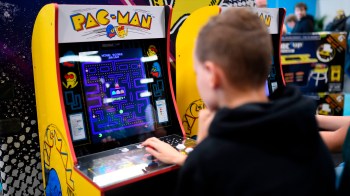Switching up the violent video game trend
Jeff Horwich: Last year’s best selling video game was “Call of Duty: Modern Warfare 3.” The graphics get more fancy. But shoot-em-ups are still the basic formula that game-makers market — and young male game players go for. Each time there’s a mass shooting in the real world, people ponder again the link between violent media and violent actions. The link isn’t clear in recent cases — and it’s not proven as a general matter. But is there any harm in investigating alternatives?
A small game-maker in the U.K. is calling on the industry to shake up its old, violent habits by investing in new brain-scanning technology. Chris Stevens is with me — he heads the app maker Atomic Antelope. And Chris, we’ve had years of wishful thinking on this point. So… what makes you believe that we can now find real and appealing alternatives to violence in video games?
Chris Stevens: I think there already are appealing alternatives to violent video games but I think it’s not so easy for a developer of a non-violent game to convince a games publisher that it’ll be a successful title because of the fact that neuroscientists have figured out that firing a gun in a video game creates quite a primitive dopamine response system. So you immediately feel a kind of rush of excitement and interestingly, also dampens your sense of empathy.
What I’ve been suggesting is that developers could consider looking at functional MRI responses to the video game experience. You can take a look at a weapons’ firing game like Call of Duty, or something and you can take an image of the brain reacting to that and then you could take your hypothetical new game and show the brain reacting to that and you could demonstrate the reaction pattern is the same.
Horwich: But is there anything other than shooting, stabbing and slashing that can give that kind of dopamine boost?
Stevens: Well, yeah there are other game types that stimulate other regions of the brain, games like Tetris and stuff. It provokes the brain in a strange way. If you ever played Tetris for a long period you might notice you start dreaming about Tetris blocks. It’s actually a known phenomenon that Tetris induces the brain to start dreaming about playing Tetris – it’s that powerful an effect.
Hobson: It’s not every kid whose going to play a violent video game and have it warp his mind. How do you make sure these new hypothetical games are played by the kids that we would want to be playing those games?
Stevens: Well, I mean that’s the challenge really. Games that involve weapons firing are some of the most popular so it’s a tricky challenge. But the new avenues of neuroscience research are really exciting for developers because it allows them to say to a publisher: ‘it is as compelling because we have the neuroscience data.’
Hobson: Chris Stevens founded the app developer Atomic Antelope. Thank you very much.
Stevens: Thanks so much.
There’s a lot happening in the world. Through it all, Marketplace is here for you.
You rely on Marketplace to break down the world’s events and tell you how it affects you in a fact-based, approachable way. We rely on your financial support to keep making that possible.
Your donation today powers the independent journalism that you rely on. For just $5/month, you can help sustain Marketplace so we can keep reporting on the things that matter to you.


















